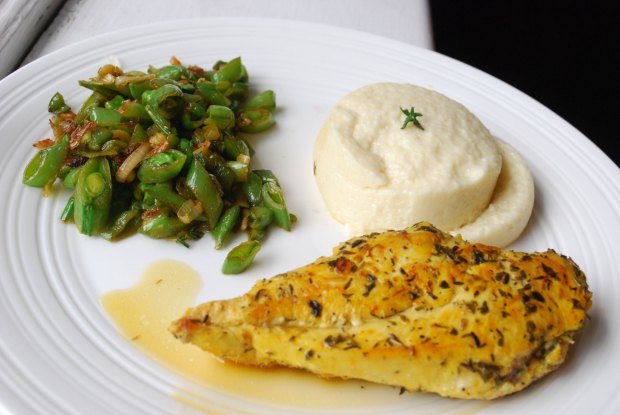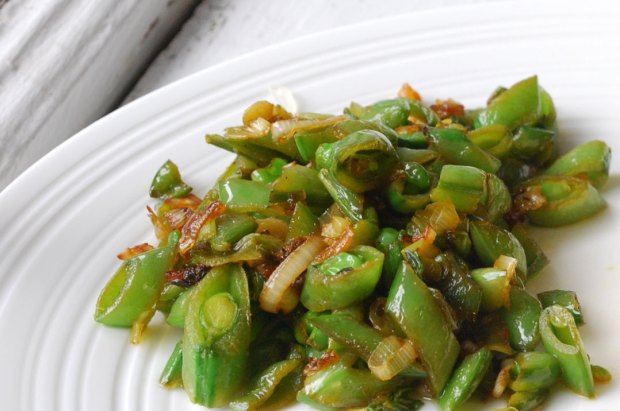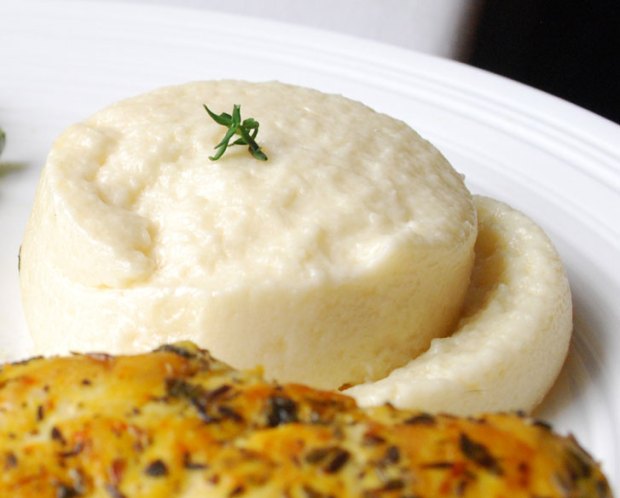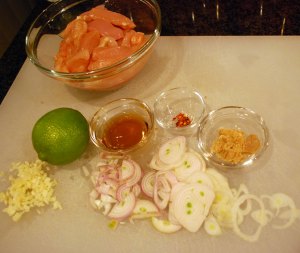I am aware that this post is coming late: spring has long since sprung. Morels, fava beans, and ramps – the heralds of the season in New England – have populated and then disappeared from the market shelves, making room for the first husks of sweet corn and mounds of heirloom tomatoes. Nevertheless, I decided last night to peruse the “Spring” chapter of one of my favorite cookbooks with the aim of giving May a proper (though belated) send-off.
Suzanne Goin’s Sunday Suppers at Lucques is a truly wonderful volume for any cook who loves to entertain. The recipes are elegant and intensely flavorful, though never overly complicated. Their simplicity is juxtaposed brilliantly with their originality – I often ask myself, “why hasn’t anyone thought of that before?” As an example, the meal I made last night involved thinly slicing sugar snap peas on the bias and sauteeing them quickly with onions and thyme, finished with saffron butter and lemon juice. Surely, one need not prepare the snap peas this way to enjoy the delicious flavor combination, but I loved the way the peas separated from the pod, creating a varied texture and a far more interesting visual on the plate than the standard whole pod.
Another lovely feature of this cookbook is that it is organized around full meals. For each season, Goin provides eight 4-course menus, including dessert. I have had great luck cooking her recipes — her instructions are very clear and concise, and she always notes when some aspect of the meal can be done ahead. Last night, I made just one course although it had three components: Saffron Chicken with Parmesan Pudding, Spring Onions, and Sugar Snap Peas. RJ and I raved about the layered flavors of the chicken breasts, and I could not get enough of the green vegetables. After an initially lukewarm reaction to the texture of the parmesan pudding, both of us came around to appreciating its subtlety when paired with the zesty chicken. Only two things would have improved this meal: first, we should have listened to Suzanne Goin and used skin-on chicken breasts. We missed the crispy goodness! Second, in making this again I will definitely whip up a quick pan sauce to accompany the protein – why waste all those rich drippings?
 Saffron Chicken, Spring Onions, and Sugar Snap Peas
Saffron Chicken, Spring Onions, and Sugar Snap Peas
Serves 6
1/2 tsp. saffron threads
3 Tbs. unsalted butter, softened
5 Tbs. extra-virgin olive oil, separated
6 boneless chicken breasts, about 5 oz. each, skin on!
1 Tbs. thyme leaves, separated
2 Tbs. sliced flat-leaf parsley
1 lemon, zested
3/4 lb. sugar snap peas, sliced on the diagonal into 1/4 inch pieces
1 1/2 c. sliced spring onions plus 1/2 c. sliced spring onion tops
4 oz. pea shoots
Toast the saffron in a small pan over medium heat until it just dries and becomes brittle. Pound the saffron to a fine powder in a mortar. Dab a tablespoon of the softened butter into the saffron powder, using the butter to scoop up about half the powder. Set aside.
Stir 4 tablespoons olive oil into the mortar, scraping with a rubber spatula to incorporate all of the saffron powder. Mix with 2 teaspoons of the thyme leaves, all of the parsley, and the lemon zest. Pour this into a large ziplock bag with the chicken breasts, coating the chicken well. Marinate in the refrigerator at least 4 hours, preferably overnight.
Heat a large saute pan over high heat for 2 minutes. Season the chicken with salt and pepper on both sides. Swirl in 1 tablespoon olive oil and wait a minute. Place the chicken, skin side down, in the pan (you might need to cook the chicken in batches). Cook for 3-4 minutes, until the skin is crispy and golden brown. Turn the breasts over, reduce the heat to medium-low, and cook them a few more minutes, until just cooked through and springy to the touch. Transfer the chicken to a resting rack.
Return the pan to the stove over medium heat for a minute. Add the remaining 2 tablespoons butter, and when it foams, add the sliced spring onions, sugar snap peas, 1/2 teaspoon salt, a pinch of pepper and the remaining teaspoon of thyme. Cook over medium heat 2-3 minutes stirring, until the onions are translucent. Add the saffron butter and 1 tablespoon water. Swirl the pan, and when the liquid comes to a simmer, toss in the pea shoots and onion tops. Immediately remove the pan from the heat and squeeze a little lemon juice over the vegetables. Taste for seasoning.
Arrange the chicken on a large warm platter and spoon the vegetables over it. Serve with the hot parmesan pudding.
Parmesan Pudding
(obviously this part of the meal is not gluten free)
3 Tbs. unsalted butter
1/4 c. plus 2 Tbs. all-purpose flour
1 3/4 c. whole milk
2/3 c. heavy cream
1 extra-large egg
1 extra-large egg yolk
1 1/4 c. grated Parmigiano-Reggiano
Kosher salt
Preheat the oven to 350 degrees F. Heat a medium pot over medium heat for 1 minute. Add the butter; when it foams, whisk in the flour, 1 Tbs. at a time, and cook for about 5 minutes, being careful not to let the flour brown. Slowly pour in the milk and cream, whisking constantly to incorporate it. The butter and flour will seize up and get pasty at first. Continue whisking vigorously as you add the liquid, and the mixture will become smooth. Cook a few more minutes, until warm to the touch. Remove the pan from the heat.
Whisk the egg and egg yolk together in a small bowl. Slowly drizzle the eggs into the cream mixture, whisking continuously until combined. Stir in the cheese, and season with a heaping 1/2 teaspoon of salt. Pour the mixture into a 8×6 inch (or equivalent) baking dish, and cover tightly with foil. [I used individual ramekins instead, and cut the cooking time to 40-45 minutes which seemed to do the trick!] Place the baking dish in a roasting pan, and add hot water to the pan until it comes halfway up the outside of the custard dish. Place the pan in the oven and bake about 1 hour, until the pudding is just set.
(You can make and bake the pudding ahead of time and refrigerate it, covered. Bring it to room temperature about an hour before serving, and rewarm it in a 400 degree F oven, 15-20 minutes, uncovered, until it’s hot and begins to brown slightly around the edges.)




 Place the chicken breasts, two at a time, between 2 sheets of plastic wrap [or in a gallon-size Ziploc bag]. Use the smooth side of a meat mallet [or a rolling pin] to pound them to about 1/2 inch thickness. Arrange the flour in a shallow bowl. Season the chicken with a pinch each of salt and pepper, and then dredge generously with flour, coating both sides. Shake off the excess and set aside.
Place the chicken breasts, two at a time, between 2 sheets of plastic wrap [or in a gallon-size Ziploc bag]. Use the smooth side of a meat mallet [or a rolling pin] to pound them to about 1/2 inch thickness. Arrange the flour in a shallow bowl. Season the chicken with a pinch each of salt and pepper, and then dredge generously with flour, coating both sides. Shake off the excess and set aside. Add the garlic to the pan and cook, stirring, for 30 seconds. Add the white wine and the lemon juice. Simmer, scraping up the browned bits on the bottom of the pan for a few minutes until almost all the liquid is gone. Add the chicken stock, tomatoes, and capers. Increase the heat to high, and bring the liquid to a boil. Simmer for 6 minutes, or until the liquid is decreased by about one-third.
Add the garlic to the pan and cook, stirring, for 30 seconds. Add the white wine and the lemon juice. Simmer, scraping up the browned bits on the bottom of the pan for a few minutes until almost all the liquid is gone. Add the chicken stock, tomatoes, and capers. Increase the heat to high, and bring the liquid to a boil. Simmer for 6 minutes, or until the liquid is decreased by about one-third. As they say, “when the cat’s away, the mice will play.” Though I’m not sure it’s the perfect analogy, I must say I did feel a rush of culinary freedom when I found out I was going to have a weekend in the kitchen without my husband around. Of course, of course, I miss him terribly. However, the thought of being able to cook any combination of fish, vegetables, or ethnic food I can dream up is nearly intoxicating.
As they say, “when the cat’s away, the mice will play.” Though I’m not sure it’s the perfect analogy, I must say I did feel a rush of culinary freedom when I found out I was going to have a weekend in the kitchen without my husband around. Of course, of course, I miss him terribly. However, the thought of being able to cook any combination of fish, vegetables, or ethnic food I can dream up is nearly intoxicating.
 Directions:
Directions:

 2 Tbs. vegetable oil
2 Tbs. vegetable oil Heat the oil in a well-seasoned wok or a heavy-duty 12-inch skillet over medium-high heat until shimmering hot. Add the shallots, garlic, and red pepper flakes; cook, stirring frequently, until the shallots start to soften but not brown, 1 to 2 minutes. Add the chicken and cook, stirring, until it’s no longer pink and the shallots are beginning to brown, 2 to 3 minutes.
Heat the oil in a well-seasoned wok or a heavy-duty 12-inch skillet over medium-high heat until shimmering hot. Add the shallots, garlic, and red pepper flakes; cook, stirring frequently, until the shallots start to soften but not brown, 1 to 2 minutes. Add the chicken and cook, stirring, until it’s no longer pink and the shallots are beginning to brown, 2 to 3 minutes.